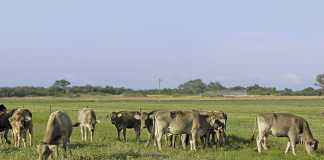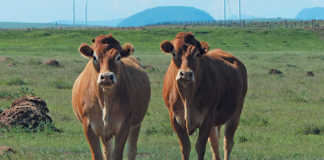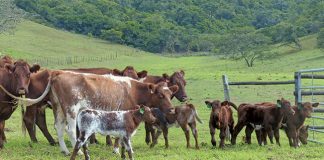Freeze branding is not a new concept to South African agriculture, yet it is only in recent years that it has gained in popularity among dairy farmers to facilitate easier herd management. Lloyd Phillips discovers how freeze branding works, and how it helps farmers.
With lost and stolen cattle becoming a massive problem for farmers around the country, it has become law for all livestock owners to apply for a registered brand and to put this official mark on all their animals in an appropriate manner. While tattooing is more commonly used on horses and sheep, hot branding is the preferred method used by farmers for applying permanent registered brands to their cattle.
Hot branding involves heating branding irons in a fire until they are red hot, and then pressing the irons against the hide of a cow or bull, leaving a visible scar on the animal once the burn has healed. The Registrar of Brands allocates each livestock owner a specific mark for use on the farmer’s animals.
According to Mooi River dairy farmer David Davies of Nutcombe Farm, KwaZulu-Natal, he still uses hot branding on his animals when applying the farm’s registered brand.
“I don’t use the hot-brand marking for identifying cows when heat spotting, for veterinary reasons, or when milk recording. This brand is solely for ownership identification purposes, “ David says. “I have found that freeze branding is much better when used to mark individual animals with a specific number to improve on-farm management of my animals.”
In contrast to hot branding, freeze branding requires branding irons to be submerged in dry ice (-79°C) or liquid nitrogen (-196°C) until the irons are so cold that they will leave a permanent mark on the animal after being applied to the hide. The mark is as a result of the extremely cold iron killing off the pigment follicles under the hair where the freeze brand is applied on an animal. In animals where the white hair colour gene exists, the hair under the freeze-brand site will grow back a highly visible white colour.
KZN freeze-brander Bonnie Phipps says freeze branding requires specialised equipment and must be carried out with care to ensure an effective brand. “There are different lengths of time for different cattle ages that a freeze brand must be held against the hide for it to take properly. The brand’s visibility is not immediate. After the initial freeze branding, the site of the brand will swell. A scab will form and drop off after a few weeks. Thereafter, the hairs on the brand site will begin growing back white,” explains Bonnie.
According to the website www.lhbrandingirons.com, freeze brands do not always show up well on lighter-coloured animals or those with no white hair colour gene. In these cases, the site suggests that the freeze brand should be held against the animal’s hide for a longer duration in order to leave a scar-like brand, much the same as would result from hot branding.
Flourishing freeze-branding business
Bonnie’s freeze-branding services are in growing demand among dairy farmers in KZN. In just over a year, she has freeze-branded approximately 6 000 animals. She says that the reason for this demand is that the freeze brands are so much easier to use for identifying specific dairy animals than the more traditional ear tags or ear notches.
She notes, “It is difficult to observe the ear tags or ear notches when the animals are in the parlour as their heads are usually in a feed trough during milking, and the staff are working with the milking equipment behind the cows. So to make it easier to identify their cows, dairy farmers are asking me to freeze brand their animals down the hindquarters on either side of the tail.”
David is using Bonnie’s freeze-branding services to compare the effectiveness of liquid nitrogen against that of previously used dry ice. He only freeze-brands his yearling heifers as it is especially from this age that he will need more stringent animal management. His heifer calves are only ear-notched and ear-tagged. In addition, Bonnie prefers to freeze-brand older animals, as their hides are thicker and less likely to suffer injury from the process than the thinner hides of calves.
The procedure
When freeze branding, Bonnie needs at least three of a farmer’s staff members to help her. One staff member uses animal hairclippers to clip the areas that will be freeze-branded. The short hair allows the freeze-brand iron to better penetrate down to the hair colour follicles. The animal is then restrained in a neck clamp, and Bonnie then liberally applies methylated spirits to the branding site.
She explains, “The methylated spirits act almost like an adhesive between the branding iron and the hide. I then hold the iron against the hide for a predetermined time, and the animal is then released back into the herd. Within about three months, the cow will have a permanent and highly visible freeze brand.”
Bonnie’s equipment includes a full set of specially made branding irons, large flasks of liquid nitrogen, a big container of methylated spirits, a spray bottle to apply the meths, funnels for decanting the liquid nitrogen into the reinforced cooler box where her branding irons are chilled, a thick pair of welding gloves to protect her hands from the liquid nitrogen and the clippers themselves.
An aspect to consider during the freeze-branding process is not to allow an electric cattle prodder to be used on an area of hide that has been sprayed with meths. It is not unheard of for the liquid to catch alight from the spark generated by the prodder. “I’m very happy with the freeze brands on my cows that were previously made using dry ice,” David concludes. “The brands are very visible, the cows recover quickly, and there is less chance of a freeze brand becoming infected than with a hot brand. We’re now going to wait and see what the brands look like after using liquid nitrogen.”













